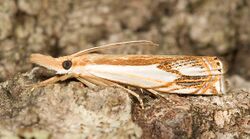Biology:Crambus agitatellus
| Crambus agitatellus | |
|---|---|

| |
| Scientific classification | |
| Domain: | Eukaryota |
| Kingdom: | Animalia |
| Phylum: | Arthropoda |
| Class: | Insecta |
| Order: | Lepidoptera |
| Family: | Crambidae |
| Genus: | Crambus |
| Species: | C. agitatellus
|
| Binomial name | |
| Crambus agitatellus Clemens, 1860
| |
| Synonyms | |
| |
Crambus agitatellus, the double-banded grass-veneer moth, is a moth of the family Crambidae. The species was first described by James Brackenridge Clemens in 1860. Adults are on wing from June to August.
Description
Adult double-banded grass-veneers have a wingspan of 17–22 mm. They rest with their forewings rolled tightly over their hindwings, giving them a long and slender appearance at rest. The forewings have a broad white stripe which is tapered at both ends. In some individuals, this marking may be bisected by a faint yellow stripe. 4 or 5 black lines extend from end of this white stripe and eventually meet a yellow-orange horizontal line near the end of the wing. The hindwings are pale gray or brown and lack markings.[1]
Range and Habitat
C. agitatellus is found in the eastern two-thirds of the United States and south-eastern Canada . The species is most commonly found in open grassy areas such as fields and lawns.[2]
Ecology
The larvae feed on various grasses and other low-growing plants.
References
External links
Wikidata ☰ Q5181825 entry
 |

